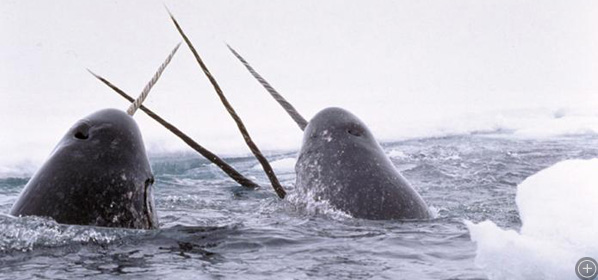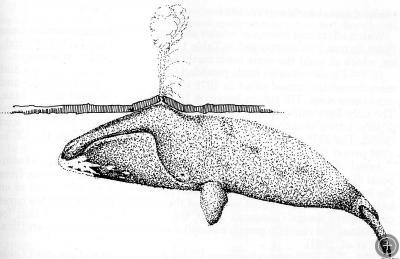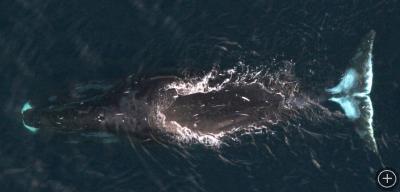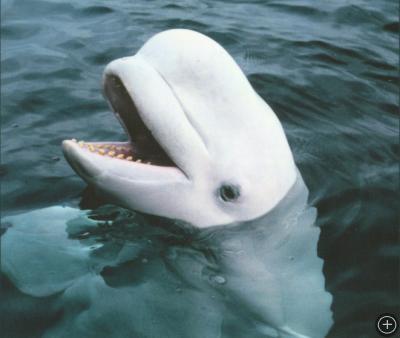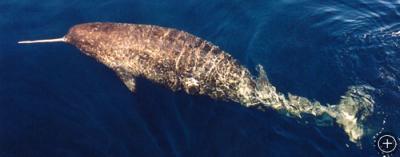Arctic Whales
The Artic summer welcomes many species of whales back from lengthy migrations, including the gray, blue, fin, and minke whales, but a fascinating trio—the bowhead, beluga, and narwhal—make their home in the Arctic and subarctic year round.
Bowhead
The 50-to-60-foot-long (15 m–18 m) bowhead spends its life near the edges of the sea ice, migrating as the ice expands or recedes with the seasons. It’s protected from the cold waters by a thick layer of blubber, and its exceptionally strong triangularly shaped skull lets it break through a foot (30 cm) or more of ice to breathe.
The bowhead is a baleen whale. Instead of teeth, it has several hundred fringed plates, called baleen, that hang down from its upper jaw and filter small prey from the water. When feeding, the bowhead swims with its huge mouth open, taking in enormous amounts of water and trapping copepods, krill, and other drifting crustaceans.
To some indigenous Arctic people, such as the Iñupiaq of the Barrow, Alaska, area, the bowhead has been a major food source, with the whale hunt a centerpiece of their culture for at least 2,000 years. Commercial hunting, which took place mainly between the mid-1800s and the early 1900s in the western Arctic, has been banned since 1946, but the International Whaling Commission allows subsistence hunters to take a specified number of bowheads each year.
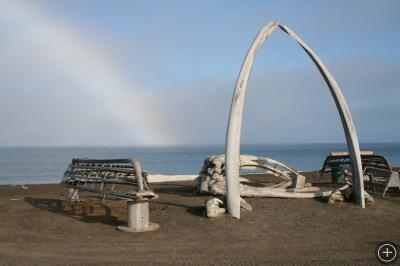
Bowhead whale bones, like these in Barrow, Alaska, are a common site in areas with populations of subsistence hunters.
The long history of bowhead hunting is helping to shed light on the lifespan of these whales. Several bowheads caught near the turn of the twenty-first century were found with old harpoon tips in their bodies, while others contained stone spearheads. In conjunction with other evidence, these weapons suggest that bowheads can live for well over a hundred years—quite possibly making them the world’s longest-lived mammals.

The bowhead got its name because its upper jaw has some resemblance to an archer’s bow. Its head is immense, making up about one-third of its body length.
Beluga
As the bowheads migrate northward, following cracks in the ice known as leads, they are often accompanied by belugas. One beluga population migrates from the Bering Sea to the Beaufort Sea, as does the main population of bowheads. But the two whales are quite different.
The beautiful beluga, also known as the white whale because of its adult coloring, is of medium size as whales go, with a maximum length of 20 feet (6 m). It’s a toothed whale with a varied diet that includes fish, squid, shrimp, and marine worms. The beluga itself is prey for orcas, polar bears, and some indigenous Arctic people.
Belugas are a sociable bunch, often gathering in large numbers, and most of them are chatty as well. Their vocalizations, which include whistles, clicks, and grunts, earned them the nickname “sea canary.” In the summer, different groups of belugas will come together in the relatively warm waters of estuaries and the nearby coastal waters. Beluga mothers seem to find the quiet estuaries ideal for raising their newborns or yearlings—but it’s also a good environment for the belugas to molt. They have extremely thick skin that they shed all at once each summer, often rubbing on the bottom of the estuary to speed the process along. New skin cells grow rapidly.
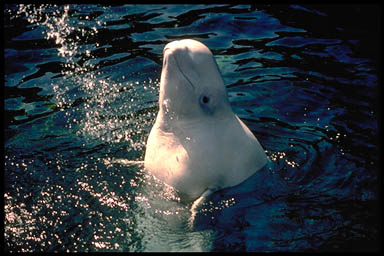
Like bowheads and narwhals, belugas have no dorsal fin– enabling them to swim more easily under the ice.
Once commercially hunted, the much-admired beluga is now a star attraction in the growing ecotourism industry. It‘s also a poster child for ocean conservation. As a top predator, it’s being contaminated by toxic chemicals that are concentrated high in the food chain.
Narwhal
Closely related to the beluga, the slightly smaller narwhal that’s found primarily in the eastern Arctic shares many biological and ecological characteristics with the white whale: It’s usually found in groups, it’s quite vocal, and it has a similar diet. What distinguishes the narwhal from the beluga—and from all other creatures—is its magnificent tusk.
Unlike the tusks of elephants and other animals, the narwhal tusk is a tooth. This whale has two teeth. In the male, the left tooth grows out through its lip, reaching a length of about 9 feet (3 m). A small percentage of females grow a shorter tusk, and males occasionally grow double tusks.
During medieval times, narwhal tusks were sold for vast sums in Europe as unicorn horns, which were thought to cure a variety of diseases and even to neutralize poisons. It wasn’t until the late seventeenth century that the origin of the tusks started to become known.
But the discovery of the “unicorn of the sea” created a scientific puzzle—what was the purpose of the tusk? Many theories were proposed; for example: males dueled with their tusks, they impressed the ladies, they punched holes in the ice; they poked the ocean floor to find food. None of the long laundry list of theories gained general acceptance, though.
In 2000, dentist and marine mammal researcher Martin Nweeia, long fascinated with the narwhal’s extraordinary tooth, became the principal investigator for the Narwhal Tooth Expedition and Research Investigation. A multidisciplinary team was established, and what they found was remarkable. Using an electron microscope, the researchers determined that about 10 million nerve endings tunnel from the core to the outer surface of the tusk. That makes the tusk an incredible sensory device, capable, the scientists think, of detecting slight changes in temperature, pressure, and much more. The tusk might let a whale know when the sea is about to freeze over, for example, or give it other life-sustaining information about its environment.
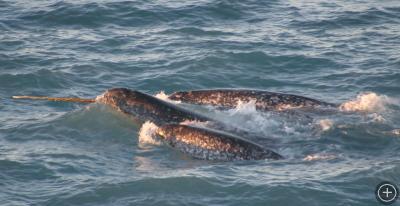
While narwhals are often spotted swimming in groups of 15 to 20, narwhal gatherings of hundreds– and even several thousand– have been reported.
The narwhal is faced with the same threats as the beluga, but it’s under additional pressure from hunting because of its valuable tusk. A tusk sells for several thousand U.S. dollars, while a rare skull with double tusks can cost $30,000 to $50,000, and sometimes even more. The United States and a few other countries forbid the import of narwhal tusks, but there are markets around the world clamoring for them. Scientists and environmentalists urge better oversight of narwhal hunts as well as lower, strictly enforced catch limits.

